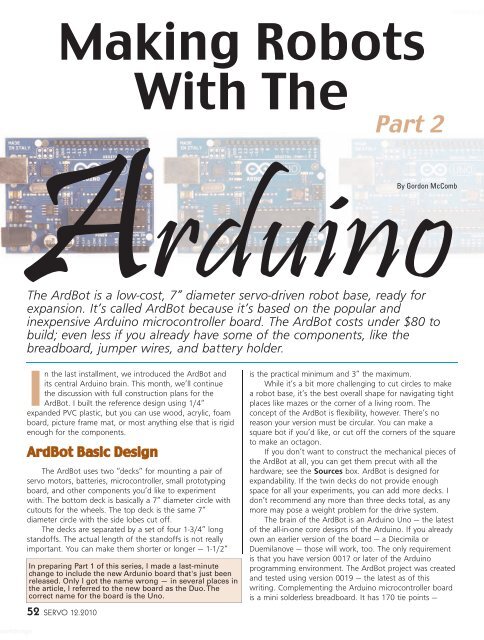Create successful ePaper yourself
Turn your PDF publications into a flip-book with our unique Google optimized e-Paper software.
worldmags<br />
Making Robots<br />
With The<br />
Arduino<br />
The ArdBot is a low-cost, 7” diameter servo-driven robot base, ready for<br />
expansion. It’s called ArdBot because it’s based on the popular <strong>and</strong><br />
inexpensive Arduino microcontroller board. The ArdBot costs under $80 to<br />
build; even less if you already have some of the components, like the<br />
breadboard, jumper wires, <strong>and</strong> battery holder.<br />
In the last installment, we introduced the ArdBot <strong>and</strong><br />
its central Arduino brain. This month, we’ll continue<br />
the discussion with full construction plans for the<br />
ArdBot. I built the reference design using 1/4”<br />
exp<strong>and</strong>ed PVC plastic, but you can use wood, acrylic, foam<br />
board, picture frame mat, or most anything else that is rigid<br />
enough for the components.<br />
ArdBot Basic Design<br />
The ArdBot uses two “decks” for mounting a pair of<br />
servo motors, batteries, microcontroller, small prototyping<br />
board, <strong>and</strong> other components you’d like to experiment<br />
with. The bottom deck is basically a 7” diameter circle with<br />
cutouts for the wheels. The top deck is the same 7”<br />
diameter circle with the side lobes cut off.<br />
The decks are separated by a set of four 1-3/4” long<br />
st<strong>and</strong>offs. The actual length of the st<strong>and</strong>offs is not really<br />
important. You can make them shorter or longer — 1-1/2”<br />
In preparing Part 1 of this series, I made a last-minute<br />
change to include the new Ardunio board that's just been<br />
released. Only I got the name wrong — in several places in<br />
the article, I referred to the new board as the Duo. The<br />
correct name for the board is the Uno.<br />
52 SERVO 12.2010<br />
Part 2<br />
By Gordon McComb<br />
is the practical minimum <strong>and</strong> 3” the maximum.<br />
While it’s a bit more challenging to cut circles to make<br />
a robot base, it’s the best overall shape for navigating tight<br />
places like mazes or the corner of a living room. The<br />
concept of the ArdBot is flexibility, however. There’s no<br />
reason your version must be circular. You can make a<br />
square bot if you’d like, or cut off the corners of the square<br />
to make an octagon.<br />
If you don’t want to construct the mechanical pieces of<br />
the ArdBot at all, you can get them precut with all the<br />
hardware; see the Sources box. ArdBot is designed for<br />
exp<strong>and</strong>ability. If the twin decks do not provide enough<br />
space for all your experiments, you can add more decks. I<br />
don’t recommend any more than three decks total, as any<br />
more may pose a weight problem for the drive system.<br />
The brain of the ArdBot is an Arduino Uno — the latest<br />
of the all-in-one core designs of the Arduino. If you already<br />
own an earlier version of the board — a Diecimila or<br />
Duemilanove — those will work, too. The only requirement<br />
is that you have version 0017 or later of the Arduino<br />
programming environment. The ArdBot project was created<br />
<strong>and</strong> tested using version 0019 — the latest as of this<br />
writing. Complementing the Arduino microcontroller board<br />
is a mini solderless breadboard. It has 170 tie points —<br />
worldmags




